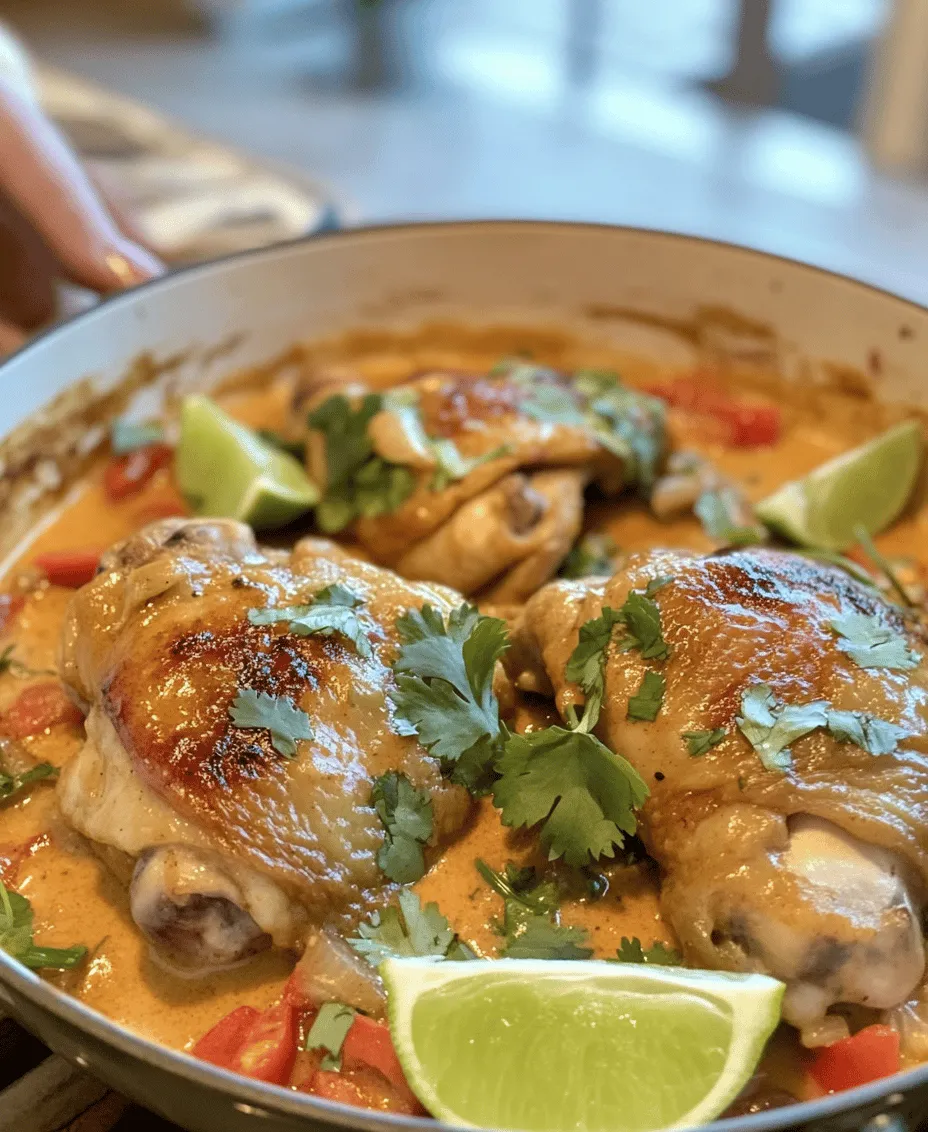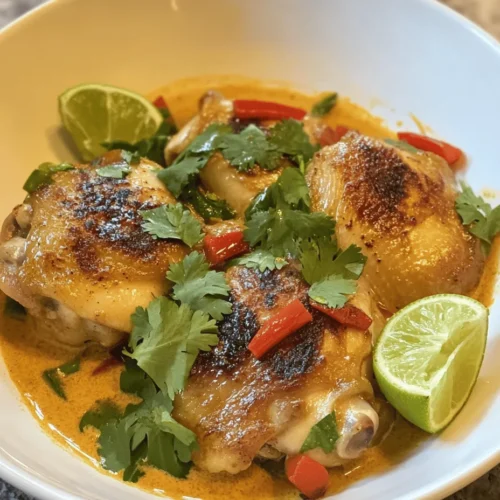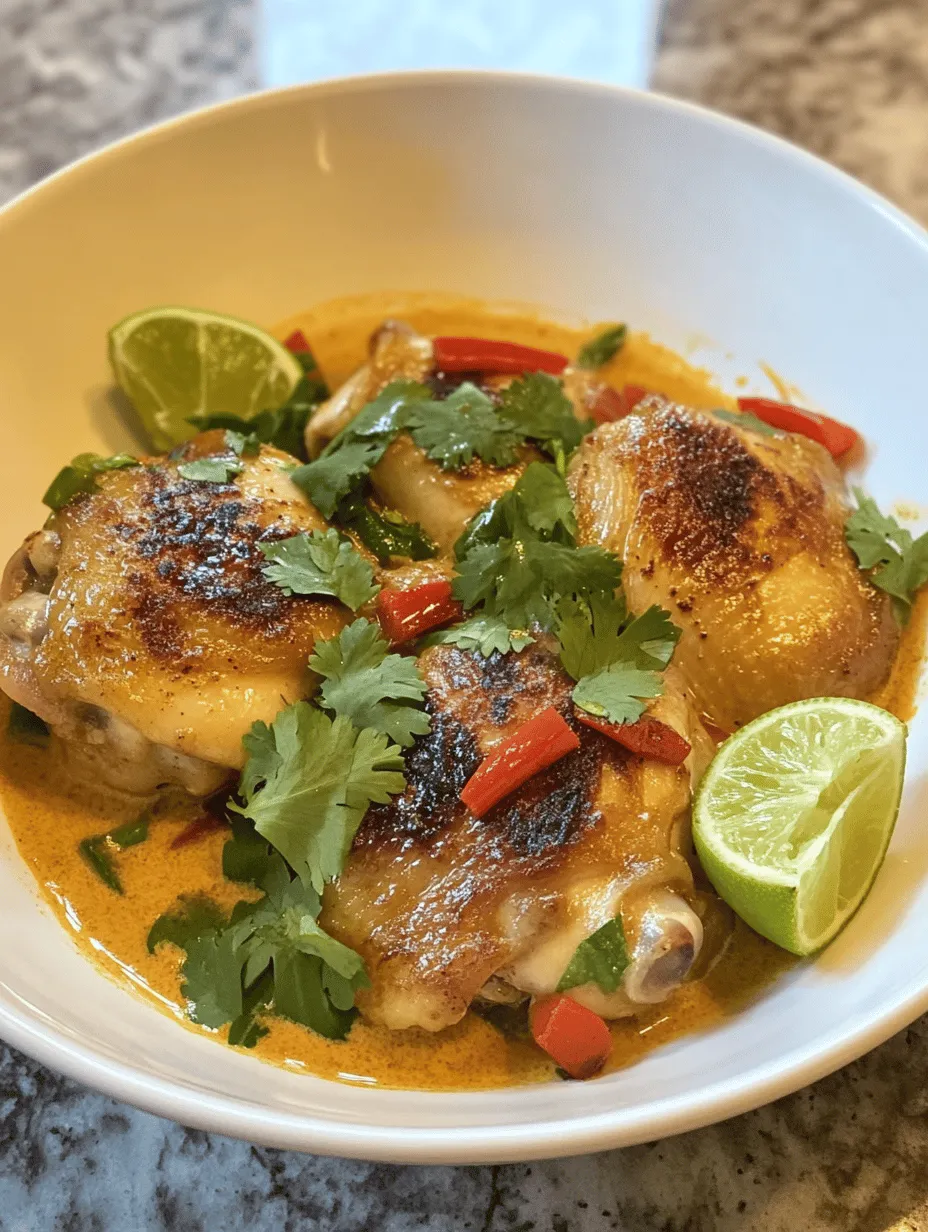The Spicy Brazilian Coconut Chicken is more than just a meal; it is a vibrant expression of Brazil’s rich culinary heritage. This dish combines the creamy richness of coconut milk with the warmth of spices and the zesty brightness of fresh lime, creating an unforgettable flavor experience. Whether you are hosting a family dinner, a gathering with friends, or simply looking for a comforting weeknight meal, this recipe promises to delight the senses and transport you to the sunny shores of Brazil.
In this article, we will explore the origins of this exquisite dish, delve into the unique flavor profile that defines Brazilian cuisine, and provide you with a detailed step-by-step guide to crafting this culinary delight in your own kitchen.
Understanding Brazilian Cuisine
Exploring the Roots of Brazilian Cooking
Brazilian cuisine is a melting pot of flavors, influenced by a blend of indigenous, African, and European culinary traditions. The country’s diverse geography, ranging from the Amazon rainforest to the coastal cities, has given rise to a wide variety of regional dishes that showcase local ingredients and cooking methods.
1. Historical Influences on Brazilian Food: The indigenous peoples of Brazil were the original inhabitants, utilizing local ingredients like cassava, maize, and tropical fruits. The arrival of Portuguese colonizers in the 16th century introduced new cooking techniques, ingredients, and spices, including garlic, onion, and various meats. Over time, the African diaspora brought in unique cooking styles and ingredients such as okra and palm oil, further enriching Brazil’s culinary landscape.
2. The Role of Spices and Herbs in Brazilian Dishes: Spices and herbs are fundamental to Brazilian cuisine, often used to create vibrant and aromatic flavors. Ingredients like cumin, coriander, and bay leaves are common, while fresh herbs like cilantro and parsley add brightness and depth to dishes. The use of chilies varies by region, with some areas embracing heat while others prefer milder flavors.
Coconut in Brazilian Culture
Coconut is a staple ingredient in Brazilian cooking, especially in the northeastern regions of the country. It is celebrated for its versatility and flavor, appearing in both sweet and savory dishes.
1. Importance of Coconut in Brazilian Cooking: The coconut palm is often referred to as the “tree of life” in Brazil, providing food, drink, and materials for various uses. Coconut milk is a key component in many traditional dishes, imparting a creamy texture and subtle sweetness that pairs beautifully with spices and seafood.
2. Varieties of Coconut-Based Dishes: From coconut rice to coconut-based stews like “moqueca,” the use of coconut spans a wide range of culinary applications. Desserts such as “cocada” (coconut candy) and “quindim” (coconut custard) highlight the ingredient’s sweet side, while savory dishes like our Spicy Brazilian Coconut Chicken showcase its adaptability in meat recipes.
Ingredients Breakdown
To create a truly authentic Spicy Brazilian Coconut Chicken, it is essential to pay attention to the ingredients. Each component plays a significant role in developing the dish’s rich flavor profile.
Highlighting Key Ingredients
1. Chicken Thighs: For this recipe, bone-in, skin-on chicken thighs are preferred. This cut of meat is not only more flavorful than chicken breasts but also remains juicy and tender during cooking. The skin adds a delightful crispness when seared, while the bones contribute to a richer sauce.
2. Coconut Milk: The star of the show, coconut milk brings a creamy richness to the dish. It is packed with healthy fats, vitamins, and minerals. When choosing coconut milk, opt for full-fat varieties for the best flavor and texture. The creaminess of coconut milk balances the heat from the spices, creating a harmonious dish.
3. Fresh Herbs and Spices: Fresh herbs like cilantro and parsley are essential for brightening the dish, while spices such as cumin, paprika, and red pepper flakes add depth and warmth. Fresh lime juice enhances the overall flavor, providing a refreshing contrast to the richness of the coconut milk.
The Importance of Fresh Ingredients
Using fresh, high-quality ingredients is paramount in any recipe, but it is especially crucial in a dish like Spicy Brazilian Coconut Chicken, where the flavors are bold and pronounced.
– Impact of Freshness on Flavor: Fresh ingredients result in more vibrant flavors, enhancing the overall taste of the dish. Dried herbs and spices can lose their potency over time, so always opt for fresh whenever possible.
– Tips for Selecting the Best Produce and Spices: When shopping for produce, look for vibrant colors, firm textures, and a pleasant aroma. For herbs, choose bright green leaves without any signs of wilting. When it comes to spices, consider purchasing from bulk bins or specialty stores, as these sources often have fresher options.
Marinating the Chicken
Marination is a crucial step in the preparation of Spicy Brazilian Coconut Chicken. Not only does it infuse the chicken with flavor, but it also enhances its tenderness, making for a more enjoyable eating experience.
The Science Behind Marination
Marinating chicken involves soaking it in a flavorful liquid, which helps to break down proteins and improve tenderness. The acid in the marinade, often from citrus juice or vinegar, penetrates the meat, allowing flavors to seep in while also making it juicier.
– How Marinating Enhances Flavor and Tenderness: The process of marination allows the spices and herbs to permeate the chicken, creating a more robust flavor profile. Additionally, marinated chicken retains moisture better during cooking, leading to a succulent final dish.
– Recommended Marination Times for Optimal Results: For the best results, marinate the chicken thighs for at least 30 minutes, but ideally, you should aim for 2 to 4 hours. If time allows, marinating overnight can lead to even deeper flavor penetration.
Step-by-Step Marination Process
To marinate the chicken thighs effectively, follow these simple steps:
1. Prepare the Marinade: In a mixing bowl, combine coconut milk, lime juice, minced garlic, chopped cilantro, cumin, paprika, and red pepper flakes. Mix well until all ingredients are thoroughly incorporated.
2. Marinate the Chicken: Place the chicken thighs in a large resealable plastic bag or a shallow dish. Pour the marinade over the chicken, ensuring that each piece is well-coated. Seal the bag or cover the dish, and refrigerate for the recommended marination time.
3. Suggested Variations for Added Flavor Depth: For those looking to experiment, consider adding a splash of soy sauce for an umami boost or a teaspoon of ginger for a hint of warmth. If you enjoy a bit of heat, a diced jalapeño or a pinch of cayenne pepper can elevate the dish further.
Sautéing the Vegetables
Once the chicken has marinated to perfection, the next step involves sautéing a medley of vegetables that will serve as the aromatic base for the dish. This process not only adds flavor but also enhances the overall texture of the final meal.
Sautéing the vegetables allows their natural sugars to caramelize, creating a rich depth of flavor that complements the chicken and coconut milk. Begin by selecting a combination of onions, bell peppers, and garlic, which are common in Brazilian cooking.
As you prepare to sauté, remember that the key to achieving the perfect sauté is to use a high-quality cooking oil. Olive oil or coconut oil works wonderfully here, imparting additional flavor while ensuring that the vegetables cook evenly.
Step-by-Step Sautéing Process
1. Heat the Oil: In a large skillet or Dutch oven, heat a couple of tablespoons of oil over medium heat until shimmering.
2. Add the Aromatics: Start by adding diced onions and sautéing until they become translucent, about 3 to 4 minutes. Then, introduce diced bell peppers and minced garlic, cooking for an additional 2 minutes until fragrant.
3. Season the Vegetables: Sprinkle in a pinch of salt and pepper to enhance the flavors of the sautéed vegetables. You can also add a dash of cumin or paprika at this stage for an extra layer of flavor.
4. Combine with Chicken: Once the vegetables are perfectly sautéed, it’s time to add the marinated chicken thighs to the skillet. Ensure that the chicken is evenly distributed among the vegetables, allowing it to sear and develop a lovely golden crust.
As the chicken cooks, the aromatic vegetables will infuse the meat with their flavors, creating a harmonious blend that is characteristic of Brazilian cuisine.
In the next section, we will dive into the process of adding the coconut milk and simmering the dish to perfection, creating a comforting and flavorful sauce that brings this wonderful dish together.
Stay tuned as we continue our culinary journey through the heart of Brazil with this delectable Spicy Brazilian Coconut Chicken recipe.

Creating a Flavor Base
To create a truly unforgettable Spicy Brazilian Coconut Chicken, the foundation of flavor is paramount. Sautéing is a crucial step in this process, as it helps to develop deep, rich flavors that form the backbone of the dish. The importance of sautéing cannot be overstated; it allows the essential oils and natural sugars in the ingredients to caramelize, bringing out the best in each component.
Techniques for Achieving the Perfect Sauté
To achieve the perfect sauté, start by preheating your pan over medium heat. Use a heavy-bottomed skillet or a Dutch oven, as these retain heat well and distribute it evenly. Once your pan is hot, add a tablespoon of oil and allow it to heat until shimmering. This ensures that the onions, garlic, and peppers will cook quickly and evenly, enhancing their natural sweetness while preventing them from becoming mushy.
When adding your ingredients, be careful not to overcrowd the pan. Overcrowding can cause steaming rather than sautéing, leading to a lack of flavor development. Instead, work in batches if necessary. Stir occasionally but allow the ingredients to sit undisturbed for a minute or two to form a golden crust. This caramelization is key to achieving a robust flavor base for your Spicy Brazilian Coconut Chicken.
Combining Ingredients for Maximum Flavor
The trio of onion, garlic, and peppers plays a pivotal role in this dish. Onions provide a sweet and savory foundation, garlic adds a pungent depth, and peppers introduce a delightful heat. For this recipe, consider using a combination of bell peppers and a spicier variety, like jalapeños or serranos, to achieve the desired heat level.
Balancing flavors is essential; the sweetness from the coconut milk will counter the spices, while lime juice adds a refreshing brightness. For a well-rounded dish, ensure that each flavor component—sweet, spicy, and savory—complements rather than overpowers the others. Taste your mixture as you go, adjusting the seasoning with salt or a pinch of sugar to enhance the natural flavors of the ingredients.
Cooking the Chicken
Searing: The Key to Flavorful Chicken
Searing the chicken is vital for developing a rich, golden crust that adds depth to the overall flavor of the dish. Begin by seasoning the chicken generously with salt and pepper. Heat a tablespoon of oil in your skillet until it begins to shimmer, then place the chicken skin-side down.
Cooking the chicken skin-side down first not only creates a beautiful golden crust but also allows the fat to render, infusing the chicken with flavor. Avoid moving the chicken too much; let it sear undisturbed for about 5 to 7 minutes until the skin is crispy and golden. Once this side is perfectly seared, flip the chicken to brown the other side for an additional 3 to 4 minutes.
Simmering in Coconut Milk
After searing the chicken, it’s time to introduce the coconut milk. Pour the coconut milk into the skillet, ensuring that the chicken is mostly submerged. This process will transform the dish, infusing the chicken with the rich, creamy essence of coconut while keeping it moist and tender.
Simmering is crucial for achieving the perfect texture. Reduce the heat to low and cover the skillet, allowing the chicken to cook gently for about 25 to 30 minutes. This slow cooking method ensures that the chicken is cooked through while remaining tender and juicy. Be sure to check occasionally, turning the chicken halfway through cooking to ensure even tenderness.
Finishing Touches
Adjusting Seasonings
As your dish simmers, the flavors will meld beautifully. However, before serving, it’s important to taste and adjust the seasonings. A squeeze of fresh lime juice will elevate the dish, adding a zesty brightness that contrasts beautifully with the richness of the coconut milk. Fresh cilantro is another essential garnish that brings a burst of freshness to each bite. Chop it coarsely and sprinkle it generously over the chicken just before serving.
Serving Suggestions
To truly highlight your Spicy Brazilian Coconut Chicken, consider pairing it with side dishes that complement its vibrant flavors. Traditional accompaniments include fluffy white rice or coconut rice, which soak up the delicious sauce. You may also serve it with a side of black beans, which add protein and enhance the dish’s overall heartiness.
Presentation is key to a stunning dish. Serve the chicken in a shallow bowl, spooning the coconut sauce generously over the top. Garnish with lime wedges and a sprinkle of fresh cilantro for a pop of color. This not only makes the dish visually appealing but also invites diners to interact with it—squeezing fresh lime juice over their servings.
Cultural Significance of the Dish
Celebrating Brazilian Heritage
Spicy Brazilian Coconut Chicken is not just a meal; it represents the rich culinary heritage of Brazil. Brazilian cuisine is a colorful tapestry woven from indigenous ingredients, African influences, and Portuguese traditions. This dish encapsulates the warmth and hospitality that are hallmarks of Brazilian culture.
In Brazil, food is often a communal experience, shared among family and friends. This dish is a popular choice for gatherings and celebrations, symbolizing togetherness and the joy of sharing a meal. By preparing and enjoying Spicy Brazilian Coconut Chicken, you’re participating in a culinary tradition that has deep roots in community and family.
Conclusion
Spicy Brazilian Coconut Chicken is more than just a meal; it is an experience that transports you to the heart of Brazil. By understanding the ingredients, cooking techniques, and cultural significance, you can appreciate this dish on a deeper level. Whether you’re an experienced cook or a culinary novice, this recipe offers a delightful opportunity to explore new flavors and bring a taste of Brazil to your table. Indulging in this vibrant dish not only satisfies the palate but also connects you to a rich culinary tradition that celebrates community, warmth, and the joy of sharing food.
As you savor each bite of Spicy Brazilian Coconut Chicken, remember that you are enjoying a dish that embodies the spirit of Brazil—bold, vibrant, and full of life. So gather your loved ones, serve up this delectable meal, and let the flavors transport you to the colorful streets of Brazil.



